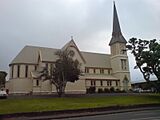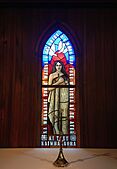Church of the Holy Sepulchre, Auckland facts for kids
Quick facts for kids Church of the Holy Sepulchre |
|
|---|---|
| St Sepulchre's | |
|
Māori: Te Mīhana Māori o Tāmaki Makaurau
|
|

Church of the Holy Sepulchre, in 2022
|
|
| 36°51′53″S 174°45′46″E / 36.864843°S 174.7628507441338°E | |
| Country | New Zealand |
| Denomination | Anglican |
| History | |
| Founded | 1880 |
| Founder(s) | Bishop William Cowie |
| Relics held | Te Take ki Oihi Crozier |
| Architecture | |
| Architect(s) | E. Mahoney and Son |
| Architectural type | Church |
| Style | Gothic Revival |
| Years built | 1880–1881 |
| Specifications | |
| Materials | Kauri timber |
| Administration | |
| Parish | Te Mīhana Māori o Tāmaki Makaurau |
| Diocese | Te Tai Tokerau |
| Province | Aotearoa |
The Church of the Holy Sepulchre (which in Māori is Te Ana Tapu), often called Holy Sep or Te Mīhana Māori, is an old Anglican church in Auckland, New Zealand. It is built in the Gothic Revival style, which means it looks like churches from the Middle Ages.
This church was started in 1880. It was designed by Edward Mahoney, a famous architect. Today, it is recognized as a very important historic building by Heritage New Zealand. The church is managed by Te Mīhana Māori, which is the Māori Anglican church in Auckland.
Contents
History of the Church
The First Church Building
The very first church, known as Old St Sepulchre's Church, was built in 1865. It was a small Anglican chapel located on Symonds Street in Auckland. Bishop Selwyn opened it in August 1865.
As more people moved to the area, the church needed to grow. In 1874, the main part of the church was made bigger. This allowed it to hold over 400 people. Soon after, people decided to build a completely new, larger church. The old church was sold in 1903 and moved to Mt Eden.
Building the New Church
The foundation stone for the new Church of the Holy Sepulchre was laid in 1880. This was done by Bishop William Cowie, who was the first Bishop of Auckland. The church was first planned for Symonds Street. However, it was later decided to build it on Khyber Pass Road. This was because Symonds Street had become too busy and noisy.
The new church was designed by Edward Mahoney. His company, E. Mahoney and Son, was known for building Gothic Revival style buildings out of wood. The church was built on top of a hill. It had a tall steeple, which was the highest in Auckland at the time.
Adding to the Church Complex
In 1898, a large wooden hall was moved to the church site. This hall was first built in 1885 as a temporary church and school for St Paul’s, Auckland's first church. After some changes, it became a Sunday school for 325 children.
Later, in the 1930s, a special small chapel called a Lady Chapel was added to the main church building.
Becoming Te Mīhana Māori
In October 1963, the church parish closed. The Auckland City Mission took over the complex. By 1969, the church became the Auckland Anglican Māori Mission. This change happened because many Māori people were moving from rural areas to cities in the 1950s and 1960s. Reverend Kīngi Īhaka oversaw this new mission.
In the early 2000s, the main church building was fully repaired. This big project cost $480,000. The tall steeple was even covered with new copper.
The Church of the Holy Sepulchre was used as a filming location in 2001. It appeared in New Zealand's first full-length movie made in the Māori language, called The Maori Merchant of Venice.
On July 4, 2009, the church hall was updated and reopened. It was named Tātai Hono, which means ‘bound together’. New carvings, woven panels, and paintings were added to the hall.
On May 28, 2023, Rev'd Shona Pink-Martin became the new Māori Missioner. She leads Te Mīhana Māori o Tāmaki Makaurau.
Church Leadership
Today, the Church of the Holy Sepulchre / Te Ana Tapu is run by Te Mīhana Māori. This is the Auckland Anglican Māori Mission. Rev'd Shona Pink-Martin is the Missioner, leading the church.
The church is overseen by Te Pīhopatanga o Te Tai Tokerau. This is the northern diocese (area) of the Māori Anglican church. Bishop Te Kitohi Pikaahu is in charge of this diocese. The church has 18 other clergy members and a team of nine staff.
Gallery





